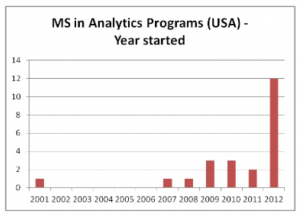AI on Campus: The Next Generation of Data Scientists
Blog: Enterprise Decision Management Blog

Artificial Intelligence is one of today’s hottest topics, in academia and in business. Here’s how the two worlds can intersect.
One of the most refreshing parts of my job involves keeping up with data science developments at leading universities. Occasionally I have the opportunity to “parachute in” to see faculty and student projects first hand, and talk with the researchers behind them. This is exactly what I did last week in New York City at Columbia University’s Data Science Day, a one-day jam that featured “lightning talks” (short, TED-like presentations) from Columbia professors, as well as dozens of student exhibits.
One of my favorite presentations at Data Science Day was by Professor Julia Hirschberg, chair of Columbia’s Data Science Department and an alumna of the venerable Bell Labs. Professor Hirschberg’s lightning talk, “Applications for Detecting Emotion in Speech and Text,” was about using AI techniques for sentiment analysis. She noted that, “Identifying the emotional content of written and spoken language is increasingly useful in business, medicine and security…. Large data sets of text and speech can be used to train systems to detect consumer reactions to products and services … to diagnose medical conditions such as depression, and identify deception in a wide variety of … settings.” Professor Hirschberg’s findings were intriguing and well presented.
Today, we use speech analysis in FICO Engagement Analyzer, helping organizations collecting debt to maintain compliance and collection effectiveness. Engagement Analyzer uses sophisticated text and speech recognition analytics to index, search, analyze and report content from collector interactions. It is interesting to consider how an additional dimension of analysis, of emotion, could someday enhance products like Engagement Analyzer.
Future scientists
I was also enthused to see a terrific turnout at Data Science Day. Hundreds of people packed into Roone Arledge Auditorium on the Columbia campus. These young researchers are looking to data science to be the tool that helps solve some of the world’s most complex challenges, to create a better society.
The large turnout reminded me of another informal data point I’d recently seen, in an article by analytics guru Gregory Piatetsky. As indicated below, data science and analytics aren’t just hot topics of study at Columbia; programs are springing at universities across the country. Piatetsky’s article listed more than two dozen analytics programs at US universities.
These anecdotal data points, along with the spirited conversations I enjoyed at Columbia Data Science Day, made me glad that artificial intelligence study is going strong on campuses everywhere, and part of the common language of hundreds of thousands of future data scientists.
I’m now on Twitter. Come follow me @ScottZoldi.
The post AI on Campus: The Next Generation of Data Scientists appeared first on FICO.
Leave a Comment
You must be logged in to post a comment.








